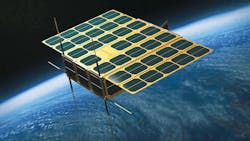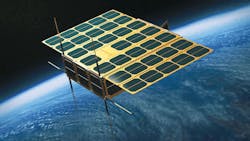Courtesy of Cannae
Recently, Elon Musk of SpaceX and Tesla Motors fame proposed colonizing Mars. In his plan, the key to getting to Mars and beyond involves refueling the spacecraft once it is in orbit. Because most of a rocket’s fuel is used just to get into Earth orbit, there’s little left to go anywhere exciting.1
Conventional chemically fueled rockets produce huge amounts of force for a few minutes. In contrast, ion thrusters on real NASA spacecraft use a high voltage to accelerate ionized gas. Once free of the Earth’s gravity, the rocket can use the ion engine to achieve very high speed even though the thrust is measured in ounces of force.
EmDrive
What about a totally new kind of rocket engine unhampered by the need for fuel? The EmDrive, invented by Robert Shawyer, is a tapered microwave resonant cavity inside which electrons resonate, but there is no fuel involved. Yet, Shawyer and others claim to have measured a net thrust.2
According to Newtonian physics, the EmDrive can’t work. If you were standing on a dock and blew sufficiently hard, you could move a sailboat in the water. But blowing against the sail doesn’t work if you’re standing on the boat.
A recent paper3 postulates that relativistic effects could be at work: a particle’s inertia may be affected by “… the Unruh radiation it sees when it accelerates.” The author derives a formula in which the difference in the diameters of the two ends of the conical EmDrive resonator corresponds to a change in particle mass. The theory isn’t perfect but does predict the order of magnitude of all the experimental results to date and comes close to actual values in many cases. Still, this is only one hypothesis, and Unruh radiation is not a fully accepted concept.
Because the resonator’s Q determines how many times a resonating particle will traverse the cavity, a very high Q facilitates generation of more thrust. LC electrical circuits have a Q of a few hundred, but a good crystal oscillator can approach 106 or even 107. Shawyer measured a Q of 5,900 for his first experimental EmDrive. Beginning in 2003, an optimized demonstration engine was developed with a Q of 45,000.4
To increase Q further, a superconducting resonant cavity has been proposed for second-generation EmDrives.5 As of August 2016, Shawyer’s website states, “Development work is continuing on superconducting EmDrive thruster technology in cooperation with a U.K. aerospace company. No details of this work can be divulged at present.”
Whether or not the EmDrive actually works, high-Q superconducting resonant cavities are real. A 2007 paper6 describes a cavity built from bulk MgB2, which is superconducting below 39 K. A Q of 220,000 was achieved and confirmed by increasing the temperature above 39 K, causing the Q to drop by a factor of 20.
Mach effect
Another low-force and possibly relativistic thruster is the Mach-effect (or Woodward-effect) drive. Einstein used the “Mach’s principle” terminology when discussing “… the proposition that the origin of inertia and inertial forces is the gravitational interaction … that the entire inertial mass of the material particle is an effect of the presence of all other masses in the universe.”7
In a 1997 paper, Woodward discusses transient rest mass fluctuations in electrical circuit components, comparing them to the change in mass of the “accelerated extended bodies” in the Nordtvelt effect. In that case, the mass changes are caused by “… the dragging of spacetime by the [extended] body.” The reason that Woodward’s drive is associated with Machian ideas is because, as Woodward explains, “… in [the test particle’s] instantaneous rest frame, the remainder of the universe appears as an enveloping accelerated body.”8
A reality check
Do these fuel-less spacecraft engines really work? None of the tests to date has been totally conclusive, but too many researchers have observed anomalous thrust for the engines to be completely dismissed. In an attempt at closure, Cannae, the company formed by Guido Fetta, designer of the Cannae Drive engine—another relativistic thruster but, according to Fetta, not like the EmDrive—announced plans in an August press release to launch a thruster on a miniaturized 6U cubesat satellite. If the test proves that the device works, at least the opportunity will be provided to eliminate the least convincing theories about how.
References
- Williamson, M., “Can SpaceX and Musk achieve their Mars dream?,” Engineering and Technology, Oct. 13, 2016.
- Hambling, D., “The ‘Impossible’ EmDrive could reach Pluto in 18 months,” Wired, July 24, 2015.
- McCulloch, M. E., “Testing quantized inertia on the emdrive,” Europhysics Letters, Vol. 111, No. 6, April 6, 2016.
- “Flight Programme,” SPR, May 2010.
- Shawyer, R., “Second generation EmDrive propulsion applied to SSTO launcher and interstellar probe,” Acta Astronautica, July 10, 2015.
- Giunchi, G. et al, “A superconducting microwave cavity made of bulk MgB2,” Superconductor Science and Technology, Vol. 20, No. 4, Feb. 26, 2007.
- Fearn., H., “Mach’s Principle, Action at a Distance and Cosmology,” Journal of Modern Physics, Vol. 6, No. 3, Feb. 2015.
- Woodward, J. F., “Mach’s Principle and Impulse Engines: Toward a Viable Physics of Star Trek?” NASA Breakthrough Propulsion Physics Workshop, Aug. 12-14, 1997.
About the Author


